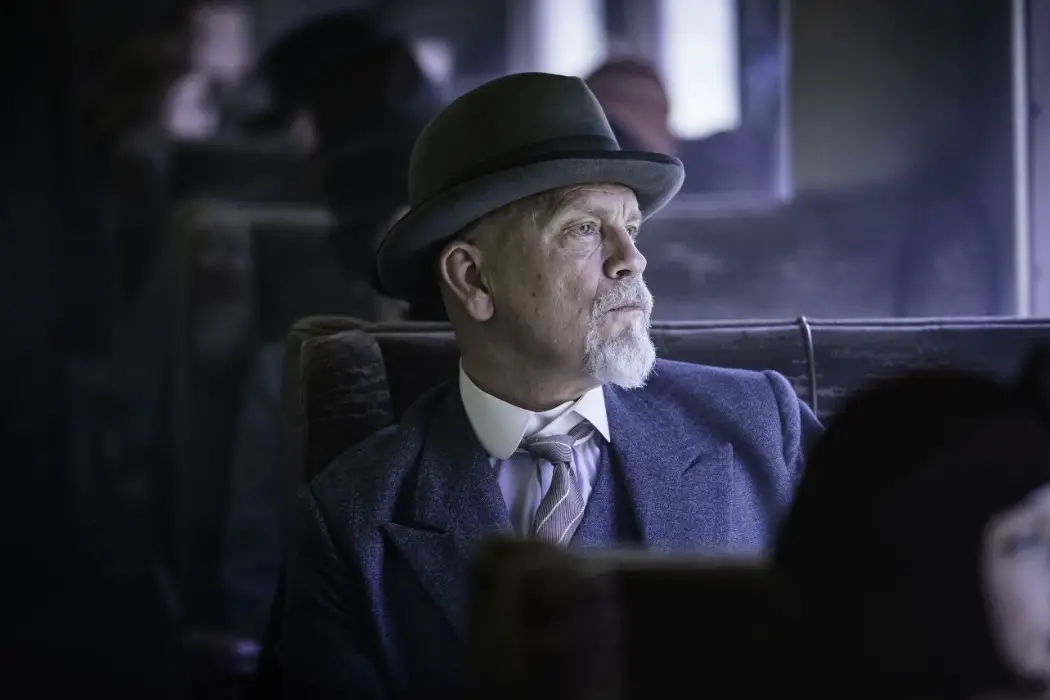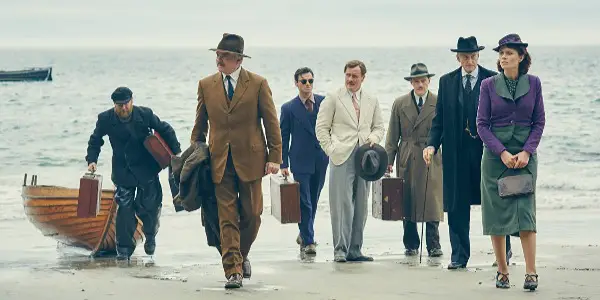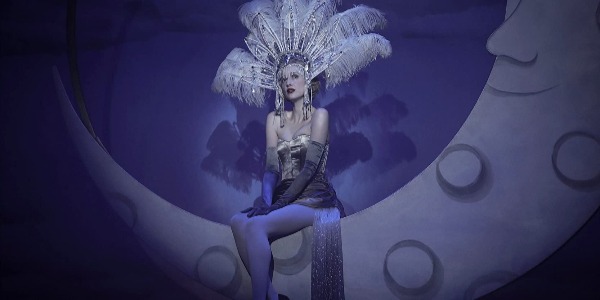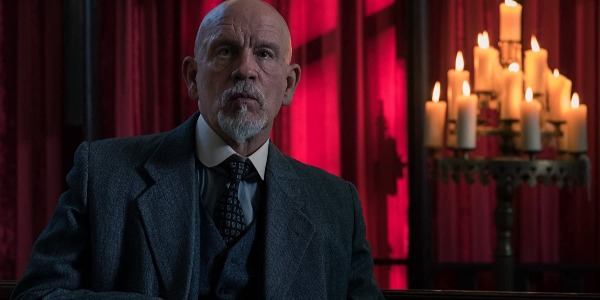Four Murders: An Omnibus Review Of Four BBC Adaptations Of Agatha Christie

Film critic, Ithaca College and University of St Andrews graduate,…
You would expect there to be flowers at the Van Gogh Museum. Landscapes, mundane still-lives, and self-portraits, sure — but Van Gogh always returned to flowers. Almond blossoms, sunflowers, irises, and orchards — they’re on full display in the Van Gogh Museum in Amsterdam. Van Gogh without his flowers would be like Agatha Christie without her detective stories.
In 2015, the Sarah Phelps-penned And Then There Were None launched a string of Christie adaptations for the BBC, all directed by different people but helmed by Phelps. Whether by attempt to buck traditionalism or foster new interpretations of the famed mystery writer’s work, each also upends expectations in odd ways.
They’re all highly revised from the original stories, for one. Most of them also don’t feature traditional detective figures — And Then There Were None finds 10 people in an old house with no idea how they’re dying one by one, The Witness for the Prosecution is less about solving the crime than it is about proving innocence, and Ordeal by Innocence takes place a full year after the case has been “solved.” The ABC Murders has a detective, at least, albeit an aged one in crisis, constantly foiled by an incompetent police force. And the most recent of them, The Pale Horse, has a detective character lingering only at the story’s periphery. (See my full, separate review of The Pale Horse here.)
The first four miniseries, each only several hours in length, at the very least make for fascinating contemporary interpretations of Christie’s classic works. And they are all incredibly popular, usually premiering on BBC One around Christmastime and drawing between 5 and 10 million viewers per episode. Sometimes Phelps’ adaptations are quite successful in their stylized, gaudy approaches to the material, but each of them commits a cardinal sin of mystery, be it one of plotting or one of tone. And then there’s And Then There Were None, which is just a bad story, full stop.
And Then There Were None
Some mysteries aren’t written for prose, character, or the gradual tightening of screws. They’re written for the final twist of the knife and the thrill of the big reveal. 2015’s And Then There Were None, a textureless three-hour miniseries full of drudgery and anticipation for the anagnorisis, represents this idea taken to its natural extreme.
In it, eight strangers disembark on a secluded island and join two servants in a palatial home, awaiting a host who never arrives for a party that never begins. We learn that they’re all murderers, of one kind or another. They’re killed off one by one in accordance to the Ten Little Indians (or “soldiers,” in this version) poem hanging on the walls of every room. It isn’t long before they’re at one another’s throats. “Will anyone survive?” the BBC announcer intones at the conclusion of an episode. If that was going to be the hook, the BBC should have picked a less revealing title… “And Possibly All of Them Died,” perhaps, would have been less obvious.
On stage and on the screen, the story has attracted ensemble casts, and the BBC has spared no expense with the likes of Douglas Booth, Maeve Dermody, Anna Maxwell Martin, Sam Neill, Miranda Richardson, and Game of Thrones alumni Charles Dance, Burn Gorman, and Noah Taylor. Aidan Turner gets to look pretty and wave a pistol about, and Toby Stephens is the most entertaining of the lot as a doctor with questionable motives. But of course, this is And Then There Were None — they’ve all got questionable motives and dark backstories, and the darker the secrets that surface, the more intriguing the drama. But the seriousness of the whole affair, combined with plodding flashbacks that do the pacing zero favors, mires the story in misery and hopelessness. We’re left nihilistically awaiting the next death and looking forward to the resolution rather than appreciating the performances and letting the story lead us merrily along.

Perhaps the plot functions better on the page, where the reader must visualize for themselves the isolation of the island and the layout of the mansion. On screen, the island is comically bare, except for the lonely little manor in the middle of nowhere, jutting out of the windswept earth like a great white pimple. For all the changes made from the source material, surely the characterization of the island did not need to be the most literal version possible. There’s nowhere to hide, nowhere to run, no place for secrets.
And then there’s the story — which, though it’s probably Christie’s most well-known, is hardly her best. The hermetically sealed murder mystery isn’t appealing, as her stories have much more to say and have more interesting plots when located within the socio-politico-economic maze of London society. And Then There Were None is more interested in human nature, that amorphous thematic beast, letting more interesting subjects like mid-1900s politics and the composition of London society fall by the wayside. It’s a murder story that intentionally excludes some of the main reasons people have murder stories.
So And Then There Were None is a fetid indulgence in the murder mystery form. So the final twist is more liable to piss you off than shock you. So there’s a ridiculous death involving someone disguised as a polar bear. So what? What the series does offer is a scene late in the grisly proceedings, when the remaining survivors get high on cocaine, drink a lot of booze, and drunkenly shout their horrible crimes to high heaven. It’s a genuinely pleasant diversion from all the dour murder and backstabbing, when the ludicrousness of the premise seems to crystallize in the minds of its characters and they can almost share a laugh with the audience. It’s not, I think, in Christie’s original story.
The Witness for the Prosecution
The best of Phelps’ adaptations is also the most somber and least showy. 2016’s The Witness for the Prosecution, previously and famously adapted by Billy Wilder, mostly rides on the beleaguered affability of Toby Jones’ solicitor protagonist, Peter Mayhew.
We’re introduced to Mayhew in unfavorable, squalid circumstances, as he shuffles through a clamorous jail, calling to the people in each cell, inquiring if they need legal representation. It’s really very endearing. And finally, someone does — Leonard Vole (Billy Howle), who stands accused of killing his mistress, the ritzy spinstress Emily French (Kim Cattrall).
Leonard has a solid alibi in the dignified actress Romaine Heilger (Andrea Riseborough), his romantic partner — if Romaine cooperates with Mayhew, that is. And there’s the late Miss French’s maid (Monica Dolan), who’s fully unhinged 100 percent of the time and way too eager to see Leonard hang (the character’s clearly inspired by Mrs. Danvers in Rebecca). There’s not much else to the drama here — it’s an ostensibly simple story that gets more murky the deeper we go, neatly paced for two hourlong episodes.

Mayhew’s a hopeless, world-weary romantic struggling to do the right thing. The First World War took his son from him, as well as most of his lungs — Mayhew has a mustard gas–induced whooping cough, with the guilt of his son’s death weighing heavily on him. Even before he admits to Leonard that he reminds him of his son, we’ve recognized that there’s something to Mayhew’s dedication beyond his obligations as an attorney.
Making the war the emotional throughline of the story is one of the best revisions of Phelps’ mostly successful reinvention of Witness for the Prosecution’s simple premise. She’s repaired the ending, too, reverting the work to Christie’s original, much darker resolution, something most other adaptations of the story happily exclude.
Witness for the Prosecution still feels televisual in terms of its overstylization and paradoxical reliance on humdrum camerawork — closeups and extreme closeups everywhere, but nary an interesting angle in sight — but sequences in the theater watching Romaine perform liven up the show in a way that can’t be said for the other Christie adaptations. Distressingly, when we aren’t in the dance hall or at the beach in the story’s epilogue, Witness for the Prosecution favors a dizzying urine-yellow color grade of heavy tungsten and shadows, presumably intended to make an already-dirty London seem squelchier.
Though maybe that visual palette is appropriate for a dark, uncertain story where nothing is as it seems, where every good decision Mayhew makes threatens to blow up in his face. But especially as we neared the bitter end, I was just hoping to see Mayhew win something, anything. Phelps’ adaptation hinges on this ambiguous view of the postwar world, where some things are too far beyond reclamation — moral righteousness, lost sons, and the soul of a war-torn country.
Ordeal by Innocence
In her metaphorical chest of characters, Phelps has several go-to archetypes. The first is a blank-canvas woman, either unruly and enraged, as Monica Dolan is in Witness for the Prosecution, or empty and vacuous, like Maeve Dermody in And Then There Were None — and this inscrutability is all the better for making incoherent choices at the drop of a hat.
The second is a sniveling, sometimes conniving, always put-upon, tapering little man, victimized by nearly everybody, and constantly being pulled into situations against his will. Other men usually punch him, shove him, and get in his face, speaking in threatening, hushed tones, savoring every word about how they’ll smash his teeth in if they see him around these parts again — it’s kind of homoerotic.
Some of these characters might all be straight from Christie’s work, but others are purely Phelps’s invention, in Witness for the Prosecution and The ABC Murders. All of Phelps’ miniseries have at least one of these archetypes, and 2018’s Ordeal by Innocence features all of them — the venomous woman, the helpless male victim, and the queer-leaning thug.
The victim sets the plot in motion — he’s Doctor Calgary (Luke Treadaway), a man with an alibi for Jack Argyll (Anthony Boyle), accused of killing his mother, Rachel (Anna Chancellor). The only wrinkle is that Calgary is late. A year late, as a matter of fact. Jack had been beaten to death in jail while awaiting trial. Whoops.
Nevertheless, this sudden influx of new information turns the remaining members of the Argyll family against one another, and over the three hourlong episodes, high acts of drama and pettiness ensue as they try to make sense of Calgary’s confession. (Notably, Ordeal by Innocence is the Christie miniseries that’s been revised the least from its original material.)

Though not the most well-paced, well-written, or coherent miniseries of the first four, Ordeal by Innocence is by far the most watchable. It’s handsomely helmed by Sandra Goldbacher, with Inverkip, Scotland, making for a gorgeous location for the petrichor murder mystery. The cast, too, comprises entirely attractive young people, especially Bill Nighy (the most affable and poised of the lot). Everyone has serious reasons to have wanted her dead — mostly because she was unnecessarily cruel to everyone, especially her adoptive children, Tina (Crystal Clarke), Mickey (Christian Cooke), Mary (Eleanor Tomlinson), Hester (Ella Purnell), and Jack. The sprawling cast of children, the dark secrets, and the regal estate recall The Haunting of Hill House more than they do any murder mystery I’d seen before. Alice Eve and Matthew Goode also star, mostly ornamentally, and Morven Christie plays Kirsten, the overworked housekeeper and the show’s only sympathetic character.
Even when the series loses the plot, or the characters’ sheer unlikability and obstinate blockheadery undermines the drama, the beautiful photography and thrill-a-minute pace of the story keep it humming along. The moments of downtime are spent awaiting Nighy’s next appearance, or Boyle’s next giddy outburst.
Boyle, playing the dead accused son, mostly appears in flashback, irritating his fastidious, loathsome mother. The flashbacks, though essential to unraveling the mystery, are clumsily introduced and often numbingly spliced into the story, via cartoonish transitions on par with Jimmy Neutron’s perturbing brain-blasts.
But the rest of the show isn’t very subtle, either. The archetypes are all turned up to 11 here. Chancellor’s mother figure is fascistic in her abusive dominance over the family, Cooke is as brutish and sneering as thugs come, and Treadaway spends half of his performance as Calgary practically falling all over the drapery in abject horror.
Still, while Nighy was sighing over his children or Goode was scheming maliciously away (a subplot that hilariously never gets resolved), Ordeal by Innocence is hardly an ordeal to watch. It might be schlock, but at least it’s well-produced.
The ABC Murders
To belabor the Van Gogh metaphor, if the BBC’s The ABC Murders were a Van Gogh, it would be his 1884 oil painting Flying Fox, of a taxidermied tropical fruit bat. Highly unusual subject matter, alternately intriguing and menacing, animalistic but a bit lifeless in the eyes, and exceedingly dark, besides a light placed behind the wings that renders the creature bizarrely translucent. The ABC Murders begins by announcing the identity of its killer — it’s a detective story where we know the surprise in advance, and the remaining three hours of television is a game of cat and mouse spread thin across three episodes. Yet if it’s Van Gogh’s Flying Fox, it is still a Van Gogh piece, just as 2018’s The ABC Murders nevertheless has a home in the BBC’s growing gallery of Christie adaptations.
The premise feels a bit murder-of-the-week: Someone is killing people with congruous initials — Alice Asher in Andover, Betty Barnard in Bexhill — and then mailing letters to the famous detective Hercule Poirot detailing their crimes. But The ABC Murders’ premiere, by spending nearly half its time with the killer, succeeds early in making the rest of the mystery perfunctory. I saw the first episode over a year ago and was so disinterested in the resolution that it took until last week for me to watch the rest of the show. For those who stick with it, though, the miniseries’ second half has a few clever, satisfying twists up its sleeve.
So far, it’s Phelps’ only series featuring Poirot, played here by John Malkovich — an astonishing casting choice that caused animosity from die-hard Christie fans. But if you watch The ABC Murders for fancy moustaches, ingenious investigations, and the thrill of the last-minute revelation, you’ve come to the wrong show. The ABC Murders continues to upend expectations, its Poirot being a withered, borderline-retired shadow of his former self, not haunted by the case so much as by trauma he’d experienced in the Rape of Belgium during the First World War.

As Poirot, Malkovich livens up the otherwise dreary plot, maintaining his poise and his hard-at-work accent despite the local police doing everything they can to trounce his investigation. Inspector Crome — played by Harry Potter’s own Rupert Grint, looking corpselike here — particularly loathes Poirot, for reasons the story doesn’t care to elaborate on.
If anything, the changes made to Christie’s original work recall the torture porn movies of the early 2000s — in one of the grislier scenes, a stocking salesman (Eamon Farren) makes his landlord’s daughter (Anya Chalotra) poke her high heels into gaping, bleeding holes in his back until the pain makes him pass out. For all the grit forced into the miniseries, the final episode, which mostly follows a series of office and parlor meetings as Poirot pieces it all together, is the most engaging, and his final tea and chat with the killer finally enters the realm of supremely entertaining television.
Some of Phelps’ changes to the material play well. Throughout The ABC Murders, there’s a potent allegory of alterity at work, as anti-immigrant signs paper the London streets and Poirot is afforded extra scrutiny on account of his immigrant status. There is little question that Phelps and Malkovich’s take on Poirot is more intriguing than how the character is usually rendered, though this Poirot deserves a better story than the ultimately grim, grimy, and ghastly ABC Murders.
Does content like this matter to you?
Become a Member and support film journalism. Unlock access to all of Film Inquiry`s great articles. Join a community of like-minded readers who are passionate about cinema - get access to our private members Network, give back to independent filmmakers, and more.
Film critic, Ithaca College and University of St Andrews graduate, head of the "Paddington 2" fan club.












